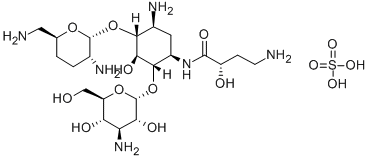Biochemical Engineering
- • Amino Acids and Proteins (221)
- • Nucleic Acid Drugs (18)
- • Enzymes and Coenzymes Drugs (115)
- • Inhibitors (1083)
- • Biological Response Modifiers (15)
- • Fat Medicines (7)
- • Amino Acids and Derivatives (4144)
- • Saccharides (2371)
- • Biochemical Reagents (322)
- • Nucleoside Drugs (346)
- • Condensing Agent (40)
- • Polypeptide (619)
- • Biosynthetic Natural Products (105)
- • Plant Extracts (813)
- • Chinese Herbs (352)
- • Microbiology Reagents (11)
- • Protein Research (34)
- • Lipids (281)
- • Inflammation Mediators (128)
Related News
-
In 2023, the international food price index fell nearly 14% YoY , and only the price index of sugar and rice rose
2024-01-10 -
Shanghai Takes the Lead in Curbing Sugary Beverage Consumption with Innovative Health Warning Labels
2023-10-19 -
Russia's Penza prefecture exported more than 1,500 tons of beet slag to China
2023-03-28 -
Bulgaria plans to introduce regulations on sugar consumption requirements
2022-12-23 -
High sugar prices in Bangladesh show no signs of abating
2022-12-14 -
How Does Sugar React With Vinegar? Vinegar And Sugar, Unlikely Couple
2022-12-09
Saccharides
Get Saccharides Raw Materials by Region-
![ARBEKACIN SULPHATE buy ARBEKACIN SULPHATE]()
Industrial Grade / 99.0%
-
![ARBEKACIN SULPHATE buy ARBEKACIN SULPHATE]()
-
![ARBEKACIN SULPHATE buy ARBEKACIN SULPHATE]()
Industrial Grade / 99%
-
![arbekacin sulfate buy arbekacin sulfate]()
Request for quotation , get quotes from more suppliers.
-
![Allyl 3-O-benzyl-a-L-rhamnopyranoside buy Allyl 3-O-benzyl-a-L-rhamnopyranoside]()
Industrial Grade / 99%
$0.2/KG EXW
-
![Allyl 3-O-benzyl-a-L-rhamnopyranoside buy Allyl 3-O-benzyl-a-L-rhamnopyranoside]()
-
![Allyl 3-O-benzyl-a-L-rhamnopyranoside buy Allyl 3-O-benzyl-a-L-rhamnopyranoside]()
Industrial Grade / 99%
-
![Allyl 3-O-benzyl-a-L-rhamnopyranoside buy Allyl 3-O-benzyl-a-L-rhamnopyranoside]()
Request for quotation , get quotes from more suppliers.
-
![1-Pyrazin-2-yl-piperidin-3-ol, 98+% C9H13N3O, MW: 179.22 buy 1-Pyrazin-2-yl-piperidin-3-ol, 98+% C9H13N3O, MW: 179.22]()
Industrial Grade / 99%
-
![Allyl 2-O-benzoyl-3-O-benzyl-a-L-rhamnopyranoside buy Allyl 2-O-benzoyl-3-O-benzyl-a-L-rhamnopyranoside]()
-
![Allyl 2-O-benzoyl-3-O-benzyl-a-L-rhamnopyranoside buy Allyl 2-O-benzoyl-3-O-benzyl-a-L-rhamnopyranoside]()
Industrial Grade / 99%
-
![Allyl 2-O-benzoyl-3-O-benzyl-a-L-rhamnopyranoside buy Allyl 2-O-benzoyl-3-O-benzyl-a-L-rhamnopyranoside]()
Request for quotation , get quotes from more suppliers.
-
![3-HydroxyMethyl-3,4,5,6-tetrahydro-2H-[1,2']bipyridinyl-4'-carbonitrile, 98+% C12H15N3O, MW: 217.27 buy 3-HydroxyMethyl-3,4,5,6-tetrahydro-2H-[1,2']bipyridinyl-4'-carbonitrile, 98+% C12H15N3O, MW: 217.27]()
Industrial Grade / 99%
-
![Allyl 2-O-acetyl-3-O-benzyl-a-L-rhamnopyranoside buy Allyl 2-O-acetyl-3-O-benzyl-a-L-rhamnopyranoside]()
-
![Allyl 2-O-acetyl-3-O-benzyl-a-L-rhamnopyranoside buy Allyl 2-O-acetyl-3-O-benzyl-a-L-rhamnopyranoside]()
Industrial Grade / 99%
-
![Allyl 2-O-acetyl-3-O-benzyl-a-L-rhamnopyranoside buy Allyl 2-O-acetyl-3-O-benzyl-a-L-rhamnopyranoside]()
Request for quotation , get quotes from more suppliers.
-
![arginomycin buy arginomycin]()
Industrial Grade / 99.0%
-
![arginomycin buy arginomycin]()
-
![arginomycin buy arginomycin]()
-
![arginomycin buy arginomycin]()
Industrial Grade / 99%
Request for quotation , get quotes from more suppliers.
Amicetin
(17650-86-1)-
![Amicetin-A buy Amicetin-A]()
Industrial Grade / 99.0%
-
![Amicetin-A buy Amicetin-A]()
-
![Amicetin-A buy Amicetin-A]()
-
![Amicetin-A buy Amicetin-A]()
- / 99%
Request for quotation , get quotes from more suppliers.
Adenosine 5′-(trihydrogen diphosphate), P′-anhydride with phosphorothioic acid, lithium salt (1:4)
(93839-89-5)-
![Adenosine 5'-[γ-thio]triphosphate Tetralithium Salt buy Adenosine 5'-[γ-thio]triphosphate Tetralithium Salt]()
-
![Adenosine 5'-[γ-thio]triphosphate TetralithiuM Salt buy Adenosine 5'-[γ-thio]triphosphate TetralithiuM Salt]()
Industrial Grade / 99%
-
![Adenosine 5'-[γ-thio]triphosphate TetralithiuM Salt buy Adenosine 5'-[γ-thio]triphosphate TetralithiuM Salt]()
-
![ADENOSINE 5-O-(3-THIOTRIPHOSPHATE), TETRALITHIUM SALT buy ADENOSINE 5-O-(3-THIOTRIPHOSPHATE), TETRALITHIUM SALT]()
Request for quotation , get quotes from more suppliers.
Acetylstrophanthidin
(60-38-8)-
![3-ACETYL STROPHANTHIDIN buy 3-ACETYL STROPHANTHIDIN]()
Industrial Grade / 99%
-
![Acetylstrophanthidin buy Acetylstrophanthidin]()
-
![3-ACETYL STROPHANTHIDIN buy 3-ACETYL STROPHANTHIDIN]()
-
![Acetylstrophanthidin buy Acetylstrophanthidin]()
Industrial Grade / 99%
Request for quotation , get quotes from more suppliers.
Adenosine 5′-(pentahydrogen tetraphosphate)
(1062-98-2)-
![adenosine 5'-tetraphosphate buy adenosine 5'-tetraphosphate]()
Industrial Grade / 99.0%
-
![adenosine 5'-tetraphosphate buy adenosine 5'-tetraphosphate]()
-
![adenosine 5'-tetraphosphate buy adenosine 5'-tetraphosphate]()
-
![adenosine 5'-tetraphosphate buy adenosine 5'-tetraphosphate]()
Industrial Grade / 99%
Request for quotation , get quotes from more suppliers.
Adenosine 5′-(tetrahydrogen triphosphate), 3′-(4-benzoylbenzoate)
(81790-82-1)-
![3'-O-(4-benzoyl)benzoyladenosine 5'-triphosphate buy 3'-O-(4-benzoyl)benzoyladenosine 5'-triphosphate]()
Industrial Grade / 99%
-
![3'-O-(4-benzoyl)benzoyladenosine 5'-triphosphate buy 3'-O-(4-benzoyl)benzoyladenosine 5'-triphosphate]()
-
![3'-O-(4-benzoyl)benzoyladenosine 5'-triphosphate buy 3'-O-(4-benzoyl)benzoyladenosine 5'-triphosphate]()
-
![3'-O-(4-benzoyl)benzoyladenosine 5'-triphosphate buy 3'-O-(4-benzoyl)benzoyladenosine 5'-triphosphate]()
Industrial Grade / 99%
Request for quotation , get quotes from more suppliers.














![3-HydroxyMethyl-3,4,5,6-tetrahydro-2H-[1,2']bipyridinyl-4'-carbonitrile, 98+% C12H15N3O, MW: 217.27 buy 3-HydroxyMethyl-3,4,5,6-tetrahydro-2H-[1,2']bipyridinyl-4'-carbonitrile, 98+% C12H15N3O, MW: 217.27](https://file.echemi.com/fileManage/upload/cas/174/36da06f4-9cf4-4c8e-af82-b9625c4bbbf7.gif)





![Adenosine 5'-[γ-thio]triphosphate Tetralithium Salt buy Adenosine 5'-[γ-thio]triphosphate Tetralithium Salt](https://file.echemi.com/fileManage/upload/canonicalSmiles/20220811/8d7e5ba9c9654c7cb216ad44eb02e080.png)



